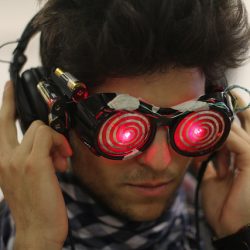The ‘Huggable Internet’ Is Changing the Game for Remote Sex
Augmented reality expert Scott O’Brien on interactive sex’s swift steps forward
Last November, Future of Sex threw our very first Meetup event in Sydney. We attracted a lively crowd who came out to see our group of thought-provoking panelists, which included augmented reality pioneer Scott O’Brien.
Scott not only shared his insights into the development of augmented reality. He also spoke about the world of online sex, and how it hasn’t always been viewed as an outlet for unbridled pleasure. However, the times are changing. Today, we have haptic technology that lets partners feel their lovers’ movements when they are far away—a move toward the “huggable Internet.”
For those of you who missed out, here’s Scott giving his clever and intriguing views on the evolution of augmented reality and remote sex. The transcript is below the video.
“It’s interesting, as things have evolved as the Internet has come into our lives. I saw a pretty good analogy the other day explaining some of the initial stages of what it meant to have remote relations online. They explained it as eating an ice cream in one hand and doing the dishes in the other. So obviously, pleasure in one hand and a task in another. In my field, augmented reality, at first it was on desktop. So you’re sitting down, that’s the experience. You’re interacting with this web camera, showing like an A4 printout against it, and a dinosaur might leap off the page or something. In 2011, we had an adult entertainment company first try to have women produced this way, and it represented that the early stages of augmented reality were very much voyeuristic. But where I believe it’s heading to and where—in 2010, I took a five-year bet, that by 2015 we’ll be moving towards more eyewear experiences where we’ll be participatory. So the whole game changes, and we start introducing haptics into our computer experiences.
“Haptics is the feedback, the kinaesthetic feedback, of interacting. Mark will have some great things to say from his days of setting up for web and 3D interaction. But I think the whole game is changing quicker than ever. We’ve had a very slow 20 odd years of remote texting and so on, but now it’s coming into actual visualizations of partner and the actual kinaesthetic feedback. A friend, Dr. Adrian Cheok, who is Aussie now based in the UK, calls it the “huggable Internet.” Once we’ve got the huggable Internet, we’re playing a different game.”
Leave a reply
You must be logged in to post a comment.

















